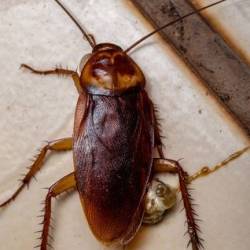American Cockroach: A Common Pest

American Cockroah
The American cockroach (Periplaneta americana) is one of the most common and widespread cockroach species in the world. Despite its name, it is not native to North America, but was introduced from Africa via ships in the 1600s. It can be found in many different habitats, especially where there is moisture, warmth and food. It is also known by other names, such as palmetto bug, water bug, sewer roach or tree roach.
Appearance
The American cockroach is the largest house-infesting roach in the United States, measuring up to 2 1/8 inches (53 mm) long. It has a reddish brown body with a pale yellow band around the edge of its pronotal shield (the plate behind its head). It has two long antennae, six spiny legs and a pair of cerci (appendages) at the end of its abdomen. Both males and females have wings, but the males’ wings are longer and extend beyond the tip of the abdomen. The American cockroach can fly, but not very well.
Behavior
The American cockroach is active mostly at night, when it searches for food and mates. It can eat a variety of foods, including decaying organic matter, fungi, algae, other insects and human food. It can survive for two or three months without food, but only for about a month without water. It prefers temperatures between 68 and 84 degrees Fahrenheit (20 and 29 degrees Celsius), and dies at temperatures below 15 degrees Fahrenheit (-9 degrees Celsius).
The American cockroach is a social insect that lives in large groups. It communicates with other roaches using pheromones (chemical signals) and sound. It can produce a hissing noise by expelling air through its spiracles (breathing holes). It can also detect vibrations and changes in air pressure with its antennae and cerci.
Reproduction
The American cockroach reproduces sexually. The male transfers a spermatophore (a packet of sperm) to the female during mating. The female then produces an ootheca (an egg case) that contains about 16 eggs. She carries the ootheca for a few days before depositing it in a hidden location. The eggs hatch after 24 to 38 days, depending on the temperature and humidity. The young roaches are called nymphs, and they look like miniature adults, but without wings. They molt (shed their skin) several times as they grow, reaching adulthood after 6 to 12 months. The adult lifespan is about one year.
Prevention Tips
The American cockroach is a pest because it can contaminate food and surfaces with its droppings and saliva, which can carry bacteria and allergens that cause diseases and allergic reactions in humans. It can also damage books, clothing, paper and other materials with its chewing and staining.
To prevent or control an infestation of American cockroaches, here are some tips:
- Seal any cracks or gaps in walls, floors, windows and doors that could allow roaches to enter your home or building.
- Eliminate sources of moisture such as leaking pipes, faucets or drains that could attract roaches.
- Clean up any spilled food or crumbs on floors, counters or cabinets that could provide food for roaches.
- Store food in airtight containers or in the refrigerator.
- Dispose of garbage regularly and keep trash cans covered.
- Vacuum carpets and furniture regularly to remove any roach eggs or debris.
- Use baits, traps or insecticides to kill or capture roaches. Follow the label instructions carefully and keep them away from children and pets.
- Hire a professional pest control service if the infestation is severe or difficult to handle.
Pest Control Options
There are different methods of pest control that can be used to get rid of American cockroaches. Some of them are:
- Baits: These are edible substances that contain insecticides that kill roaches when they eat them. They can be placed in areas where roaches are likely to feed or hide, such as under sinks, behind appliances or in cabinets. Baits are effective because they can eliminate not only the roaches that eat them, but also those that feed on their dead bodies or feces.
- Traps: These are devices that capture roaches alive or dead by using glue, sticky tape or other mechanisms. They can be placed along walls, corners or edges where roaches tend to travel or hide. Traps are useful for monitoring the level of infestation and reducing the number of roaches, but they may not eliminate them completely.
- Insecticides: These are chemicals that kill roaches by contact or ingestion. They can be applied as sprays, dusts, granules or liquids to surfaces, cracks or crevices where roaches are present or may enter. Insecticides are effective for killing roaches quickly, but they may also pose risks to humans, pets and the environment if used improperly or excessively.
- Natural Pest Control: These are methods that use natural or organic substances or organisms to repel or kill roaches. They can include plants, herbs, oils, vinegar, baking soda, diatomaceous earth, nematodes or other insects that prey on roaches. Natural pest control can be safer and more eco-friendly than chemical pest control, but they may also be less effective or require more frequent application.
The best method of pest control depends on the situation and preference of each individual. It is advisable to consult a professional pest control service for advice and assistance if needed.